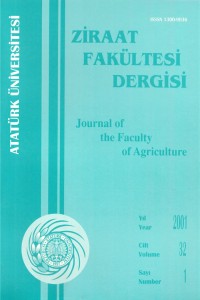Abstract
ÖZET: Silaj yapımı, su içeriği yüksek yeşil yemlerin korunması amacıyla tüm dünyada geniş olarak kullanılan bir yöntemdir. Yöntemin
esası, suda eriyebilir karbonhidratların anaerobik koşullar altında laktik asil bakterileri aracılığıyla başta laktik asit olmak üzere organik
asitlere fermente olduğu doğal fermantasyon temeline dayanmakladır. Sonuç olarak pH düşer, zararlı mikroorganizmaların etkileri
engellenir ve böylece su içeriğiyüksekyeşilyemler korunur.
Silolama işlemi başlıca dört döneme ayrılabilir. Bu dönemler: aerobik, fermantasyon, stabil, ve yemleme dönemleridir. Silaj kalitesini
sürdürmek amacsyia hasat, silo dolum, silajın depolanması ve yemleme dönemleri gibi belirgin özelliklere sahip her dönem devamlı
kontrol edilmelidir. Silaj amanejman teknikleri hakkında karar verirken, silolama işlemıi sırasında meydana gelen olayların iyi anlaşılması
Çok önemlidir.
Anahtar kelimeler: Silaj, silolama, fermantasyon.
SCLAGE FERMENTATION
SUMMARY: Silage maklng is a method of high level water content forage preservalion which is widely used ali över the world. İt is
based on natural fermentation vvhereby lactic acid bacleria change ferment vvaler soluble carbohydrates to organic acids, mainly lactlc
acid under anaerobic conditions. As a result, the pH decreases, inhibiting detrimental microorganisms, and conseouently the high level
vvaler content forages are preserved.
The ensiling process can be divided in to four main phases. These phases: aerobic, fermenlalion. stable and feedout. Each phase
has dıstinctive characteristics that musl be controlled in order to maintain forage (silage) ouality throughout the periods of harvesting,
silo filling, and silage sloring and feeding. For making decisions about silage management technioues, il is important to have a good
understanding of the evenls that occur during ensiiing process.
Keywords: Silage, ensiling, fermentation.
Keywords
Details
| Primary Language | tr;en |
|---|---|
| Journal Section | DERLEMELER |
| Authors | |
| Publication Date | January 10, 2011 |
| Published in Issue | Year 2001 Volume: 32 Issue: 1 |
Cite
Articles published in this journal are published under the Creative Commons International License (https://creativecommons.org/licenses/by-nc/4.0/). This allows the work to be copied and distributed in any medium or format provided that the original article is appropriately cited. However, the articles work cannot be used for commercial purposes.
https://creativecommons.org/licenses/by-nc/4.0/


